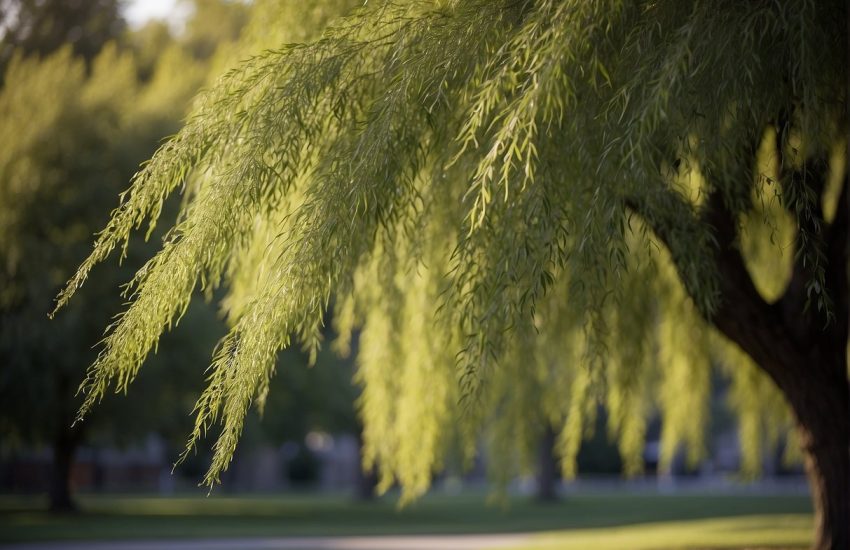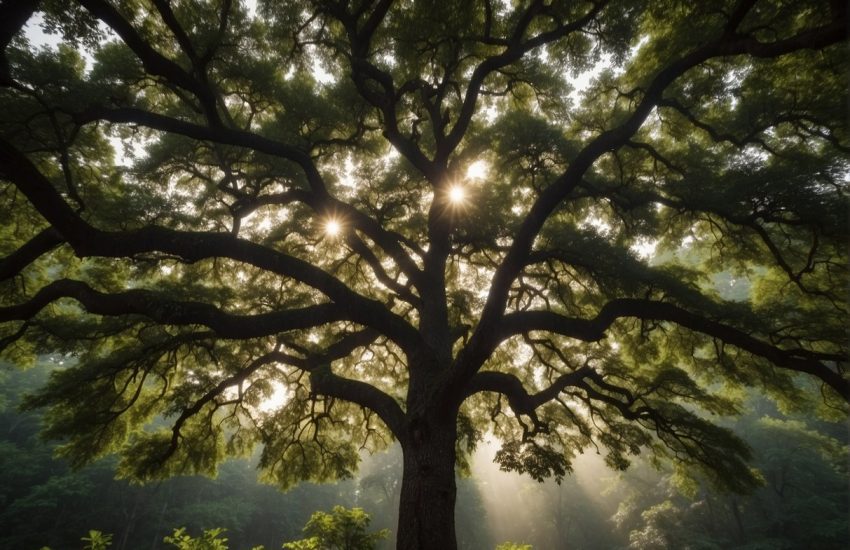The Most Beautiful Ornamental Trees to Grow in Missouri
When many people think of gardens, they envision rows of vegetables or expansive beds of flowers. However, ornamental trees can play an important role in any garden. In addition to providing visual interest, they can also help to attract beneficial insects, such as pollinators, and provide shelter for wildlife. Ornamental trees come in a wide range of shapes and sizes, so it is easy to find one that will fit your particular garden. And with a little care, they will provide you with years of enjoyment. So don’t forget to add some ornamental trees to your Missouri garden. When selecting these plants, it is important to ensure that they are suited for this region, and here are some species that will make a good fit.
Red Buckeye (Aesculus pavia)
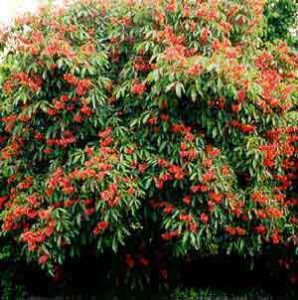
The Red Buckeye (Aesculus pavia) is a small to medium-sized deciduous tree native to the southeastern United States. It typically grows to a height of 20-30 feet and has a spread of 15-25 feet. The trunk is typically straight and slender, with smooth, reddish-brown bark. The branches are arranged in an opposite pattern and are covered with dark green leaves. The leaves are compound, with each leaflet being ovate and 2-4 inches long. In late spring, the tree produces clusters of small, red flowers, which attract bees and butterflies. The flowers are followed by shiny, brown seeds, which are poisonous if ingested. The Red Buckeye is an excellent choice for planting as a specimen tree, ornamental plant, or for use in mass plantings. It is relatively low maintenance and can even tolerate dry areas. Additionally, it provides good fall color and is deer resistant.
Catalpa (Catalpa speciosa)
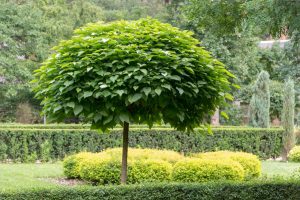
The Catalpa tree is a tall, deciduous tree that can grow up to 60 feet. It has a stout trunk and relatively large leaves that are dark green and have a heart-shaped or oval shape. The tree produces flowers that are white and have a tubular shape. These flowers are followed by long, bean-like seed pods. The Catalpa tree is native to the United States but has also been introduced to Europe, Asia, and Australia. In addition to being used as an ornamental plant, the tree has several other uses. The wood is strong and durable, making it suitable for construction and furniture-making. The bark can be used for making rope, and the seeds can be used as a source of food for certain animals. The Catalpa tree is relatively easy to grow and is tolerant of a wide range of growing conditions. It can be propagated from seed or cuttings and does not require special care once it is established.
Cockspur Thorn (Crataegus crus-galli)
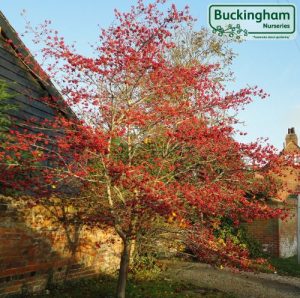
Crataegus crus-galli, also known as Cockspur Thorn, is a small deciduous tree that is native to North America. The tree gets its name from its thorns, which are long and curved like the spurs on a cock’s leg. Crataegus crus-galli is a popular ornamental plant, and it is often used in landscaping because of its attractive features. It grows to 15-20 feet tall. It is native to woodlands, hedges, and scrub in Europe, Asia, and North America. The cockspur thorn has dark green, glossy leaves that are 3-6 inches long and 2-3 inches wide. The leaves turn red or purple in the fall. The flowers are white, funnel-shaped, and bloom in May or June. They are followed by small, orange-red fruits called haws. Crataegus crus-galli is a hardy tree that is easy to care for and can tolerate full sun and partial shade. The tree grows best in moist, well-drained soil but can also adapt to dry conditions. Crataegus crus-galli is a versatile plant that can be used in many different ways in the landscape. It is an excellent choice for hedges, screens, and foundation plantings. The tree can also be trained to grow as an espalier or topiary. Whether you are looking for a plant that will add color to your garden or you need something that will provide privacy, Crataegus crus-galli is an excellent choice.
Tulip Tree (Liriodendron)
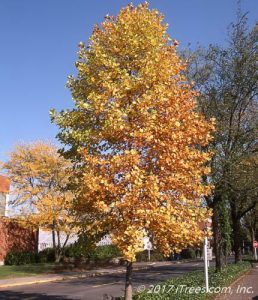
Tulip trees are stately ornamental trees that are native to North America. They get their name from their large, showy flowers that resemble tulips. Tulip trees are also sometimes called tulip poplars or yellow poplars. They are large trees that can grow up to 60 feet tall and have a spread of 30-40 feet. They have a pyramidal shape when they are young, but they eventually become more oval-shaped as they mature. The leaves are simple and alternate, and they are bright green. The flowers appear in early spring and are followed by small, triangular fruits. The bark is brown or gray and is smooth when the tree is young, but it becomes rougher and more scaly as the tree ages. Tulip trees make excellent ornamental trees for large gardens or parks due to their impressive size and striking flowers. They prefer full sun and moist, well-drained soil.
Ozark Witch Hazel (Hamamelis vernalis)
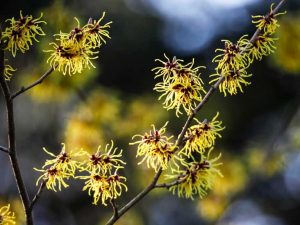
Hamamelis vernalis, more commonly known as Ozark witch hazel, is a deciduous shrub native to the Ozark Mountains of Missouri and Arkansas. Growing to a height of 15 feet, it has a spread of 10 feet and produces fragrant, yellow flowers in the late winter or early spring. The leaves are oval-shaped and have a crinkled appearance. They turn yellow in the fall before they drop off. Witch hazels are generally low-maintenance plants that are tolerant of a variety of soil types and conditions. They are also resistant to most pests and diseases. Ozark witch hazel adds interest to the landscape in spring and fall as an ornamental plant. In the spring, its flowers provide a splash of color when few other plants are in bloom. And in the fall, its leaves turn a bright yellow that contrasted nicely with other foliage colors. Witches hazels can be used as specimen plants or mass plants for a naturalistic look. Regardless of their use, they are sure to add beauty to any garden or landscape.
Saucer Magnolia (Magnolia x soulangiana)
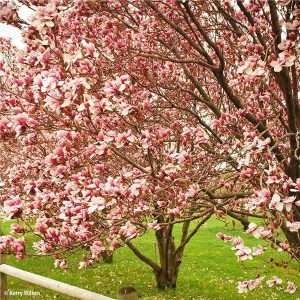
Saucer Magnolia (Magnolia x soulangiana) is a hybrid magnolia cross between M. denudata and M. liliiflora. It is a deciduous tree that can grow up to 15 m tall with a spread of 6-12 m. The leaves are ovate-shaped and 10-20 cm long, with a leathery texture and smooth margins. The flowers are white or pink, with 9-12 petals, and appear in clusters before the leaves emerge in spring. Saucer Magnolia is native to China and Japan and was introduced to Europe in 1826. It is widely grown as an ornamental tree in temperate regions worldwide.
To grow Saucer Magnolia at home, choose a location with full sun to partial shade and well-drained soil. Amend the soil with compost or manure before planting. Saucer Magnolia is best planted in spring or fall. For the tree to have a deep root system, it needs to be watered regularly during the first season. Once established, the tree is relatively drought tolerant. Prune in late winter or early spring to shape the tree and remove any dead or damaged branches. Fertilize annually with an all-purpose fertilizer in spring. The saucer magnolia is an excellent ornamental plant for gardens and parks and can also be used as a specimen tree or as part of a hedge. It is relatively low-maintenance and tolerant of urban pollution.
Downy Serviceberry (Amelanchier arborea)
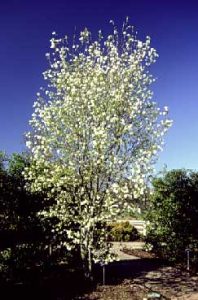
Downy Serviceberry (Amelanchier arborea) is a small deciduous tree with a spreading crown. It typically grows to 15-20 feet tall and 10-15 feet wide. The bark is smooth and brown, with prominent horizontal lenticels. The leaves are ovate to elliptical, 2-4 inches long, and arranged alternately on the twigs. They are dark green above and paler below, with serrated margins. In spring, the tree produces white flowers that bloom in clusters. These are followed by blue-black berries that ripen in early summer. The berries are edible and can be used in pies or jams or eaten fresh off the tree. Serviceberry is relatively easy to grow and is often used as an ornamental plant in landscapes. It prefers full sun but can tolerate some shade, and it tolerates a wide range of soil types. It is also relatively resistant to pests and diseases. To plant serviceberry, choose a location that receives full sun to partial shade and has well-drained soil. Dig a hole twice as wide as the root ball but no deeper. Plant the tree at the same depth it was growing in the container, and backfill the hole with soil. Water deeply after planting and keep the soil moist until the tree is established. Fertilize annually with a balanced fertilizer in late winter or early spring before new growth begins. Prune in late winter or early spring to encourage growth.
Yellowwood (Cladrastis kentukea)
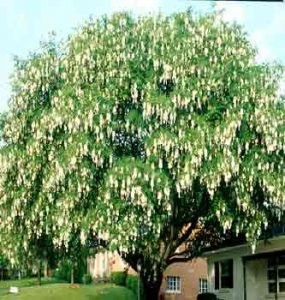
Yellowwood (Cladrastis kentukea) is a large deciduous tree native to the southeastern United States. It typically grows to 50-80 feet, with a spreading crown and horizontal branches. The leaves are alternate, pinnately compound, and have 9-17 oval-shaped leaflets. The flowers are white and fragrant and bloom in dense clusters in late spring or early summer. The fruit is a flat pod that contains several seeds. Yellowwood is often an ornamental plant due to its attractive flowers and leaves. It is also a popular choice for shade trees and street trees. Additionally, the wood of the yellowwood tree is strong and durable, making it ideal for use in furniture and flooring.

